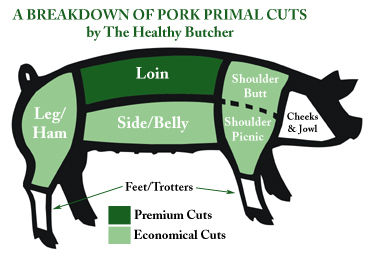
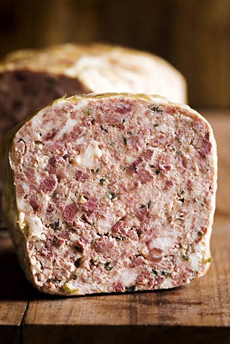 A pâté campagnola (pâté campagne in French), an example of charcuterie, is a rustic, rough-ground pork pâté. This one is available from FraMani.com. A pâté campagnola (pâté campagne in French), an example of charcuterie, is a rustic, rough-ground pork pâté. This one is available from FraMani.com.
April 2010
Last Updated March 2023
|
 |
Pork Cuts & Pork Products Glossary
Page 3: Pork Cut Types & Other Definitions With C
This is Page 3 of a nine-page glossary, including terms such as Canadian bacon, capicola, chorizo, and cracklings. Click on the black links below to visit other pages. See our many other delicious food glossaries.
This glossary is protected by copyright and cannot be copied in whole or in part.
Chart courtesy TheHealthyButcher.com. For a more detailed chart, see Page 1.
|
CANADIAN BACON
Canadian bacon, or back bacon, is lean back meat that comes from the loin section in the top center of the pig. American bacon comes from the fatty belly of the pig (see chart above). Canadian bacon is cured, but unlike conventional American Bacon, it is not smoked. Because it is cut from the loin, which is the pig’s back, it is also called back bacon. In Canada, it is simply called “bacon,” or “back bacon.” While Canadian bacon doesn’t have the smoky flavor of American bacon, it’s a way to enjoy bacon with relatively less fat. The photo at right compares Canadian bacon, on the bottom, with the fat-streaked American bacon at the top. And by the way, in Canada and the U.K., American bacon is called “streaky bacon” because of the long veins of fat that run through the meat.
|
|
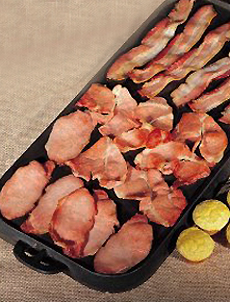
Lean Canadian bacon and “streaky” American bacon. Photo courtesy Burgers’ Smokehouse. |
|
CAPICOLA or COPPA
Capicola is a traditional Neapolitan Italian form of salume made from pork shoulder (pork butt) or neck, and dry-cured whole. It is “Italian ham,” popular on sandwiches with Provolone cheese. Technically speaking, ham is made from the rear leg, whereas capicola is made solely from the shoulder or neck. Sweet capicola is seasoned with salt and garlic; hot-style capicola adds crushed red peppers. Homestyle capicola refers to the twin wrapped around the casing; the capicola is then air-dried to intensify the flavors.
CENTER CUT PORK ROAST
See pork roast.
|
|
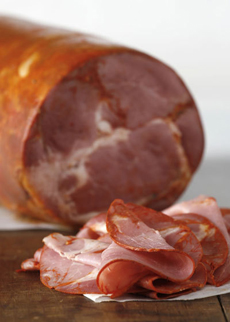
Capicola, “Italian ham.” Photo courtesy DeLallo.com. |
|
CHARCUTERIE
Charcuterie refers to pork products that are prepared, cured and preserved. Bacon, ham, sausages, terrines and pâtés are part of this group. The word also refers to the store where these products are sold. In Europe, pork products are sold in a separate store from a butcher who sells beef, lamb and other meats. In the U.S., a charcuterie has the much less glamorous name of “pork stores.”
CHEEK
See jowl.
CHICHARRÓN or CHICHARRÓNES
See pork rinds.
|
|
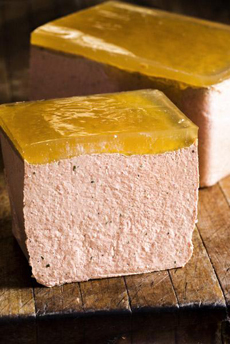
The fine texture of this pork liver mousse contrasts with the coarse-textured pâté campagnola at the top of the page. Photo by Ed Anderson | FraMani.com. |
CHITTERLINGS or CHITLINS or CHITTLINS
“Chitterlings” (pronounced CHIT-linz in America) is a Middle English word for the small intestines of the pig, as they refer to food. They are popularly fried or steamed for food. While Americans know them as a dish popular in the South, they are eaten in most parts of Europe and are also used as sausage casings.
|
CHORIZO
Chorizo is a highly-seasoned, spicy sausage: Its red color comes from spices such as paprika and chipotle. There are many different varieties, in different colors, shapes, and seasonings. Spanish chorizo is made from coarsely chopped pork and pork fat, seasoned with smoked paprika and salt. It is generally classed as either spicy or sweet, depending upon the type of smoked paprika used. There are hundreds of regional varieties of Spanish chorizo, both smoked and unsmoked, which may contain garlic, herbs, and other ingredients. Mexican chorizo is based on the recipe for uncooked Spanish chorizo, but the meat is ground rather than chopped and different seasonings are used.
|
|
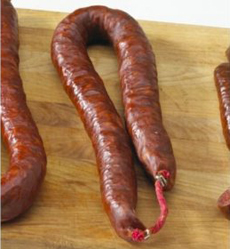
Hot stuff: Palacios Chorizo Picante from Taylor’s Market. |
Mexican chorizo is a deep reddish color and is largely available in two varieties, fresh and dried, though fresh is much more common. Mexican-style chorizo is so popular that beef, venison, kosher and vegan versions can be found. Green chorizo is a style native to Toluca, Mexico (an economic center 39 miles southwest of Mexico City). It is made with green vegetables and herbs: tomatillo, cilantro, and chiles, plus garlic. Portuguese chorizo is made with pork fat, wine, paprika, and salt. It is then stuffed into natural or artificial casings and slowly dried over smoke. Here’s what you don’t want to know: Chorizo can be made from a variety of meat cuts, including lips, lymph nodes, and salivary glands.
COLD SMOKING
See smoking.
COOKING INTERNAL TEMPERATURE
Today’s pork is bred under highly controlled hygienic conditions. While trichinosis and other food born illnesses have not been completely eliminated, it is no longer necessary to overcook pork to death. An internal temperature of 140°F is now considered safe for pork consumption.
CONNECTIVE TISSUE or COLLAGEN
Collagen is connective tissue that is found exclusively in animals (including humans). The more work a muscle does, the more connective tissue it develops over its life span. Livestock usually develop the connective tissue in their shoulders, rumps, and bellies, as those muscles do the most work (as opposed to an animal’s back, where the tenderloin is found). Connective tissue meat is tough when cooked quickly; but when slow, gentle heat is applied over time, the collagen in meat eventually denatures or “breaks down.” As a result, the meat bastes itself from the inside, making it moister and more tender (think braised beef).
COPPA
See capicola.
CRACKLINGS or PORK RINDS
Pork cracklings are the crispy fried slow roasted skin of pork. Frying and slow roasting allows the subcutaneous fat to render and melt away, leaving a crispy skin. A popular snack, pork rinds can be found in a variety of flavors, including barbecue, salt and vinegar, cheese, and even cinnamon. The difference between chicharrones, cracklings and pork rinds.
CUBED PORK
Pork cubes are cut from the Boston shoulder and are used for kebabs and stews.
|
|
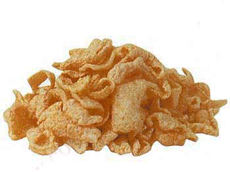
Make your own at home: See MicrowavePorkRindsOnline.com.
|
CROWN ROAST OF PORK
Cut from the rib portion of the loin, a crown roast—lamb, pork, or veal—is one of the most impressive special occasion entrées. The “crown” is made from two rib racks that are bent into a circle and then tied together with kitchen twine. The butcher can do this and present you with a handsome circle of ribs, ready to cook. The center is filled with stuffing. March 7th is National Crown Roast Of Pork Day. Here’s a delicious, easy recipe for crown roast of pork.
|
|
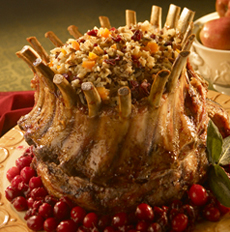
An elegant crown roast of pork. Photo courtesy Smithfield Foods. Get the recipe.
|
CULATELLO
Culatello is a refined variety of prosciutto; mentions of the delicacy date back to the 15th century. It is made from heavier pigs, and in a different fashion from prosciutto. The thigh is skinned and deboned, and the “heart,” the best part, representing a fraction of the leg, is removed and salted. (The remaining part of the meat can’t be used to make prosciutto, so what remains, called fiocchetto, is a less prestigious cut but a still tasty product.) Culatello may be cured with wine. The product is produced south of the city of Parma, home of prosciutto di Parma. As with other DOP-protected prosciuttos, it uses pigs that were born, raised, and slaughtered exclusively in Emilia Romagna and Lombard. Culatello is commonly served as a starter along with slices of sweet melon or fresh figs. See also prosciutto.
|
|
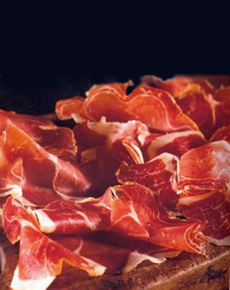
Culatello—a gourmet version of prosciutto. Photo courtesy AcademiaBarilla.com.
|
CUTLET
A thin, boneless slice (or scallop) of pork, veal, or lamb, cut from the leg or ribs. This cut is often fried. The Japanese fried pork dish, tonkatsu, is an example.
CURING
Curing is the process of adding salt and/or sugar to meat for preservation (dry cure). When brine is used, it is known as a wet cure. Smoking or air-drying is the final step.
Continue To Next Page: Pork Definitions D To G
Go To The Article Index Above
Lifestyle Direct, Inc. All rights reserved. Photos are the copyright of their respective owners.

|





